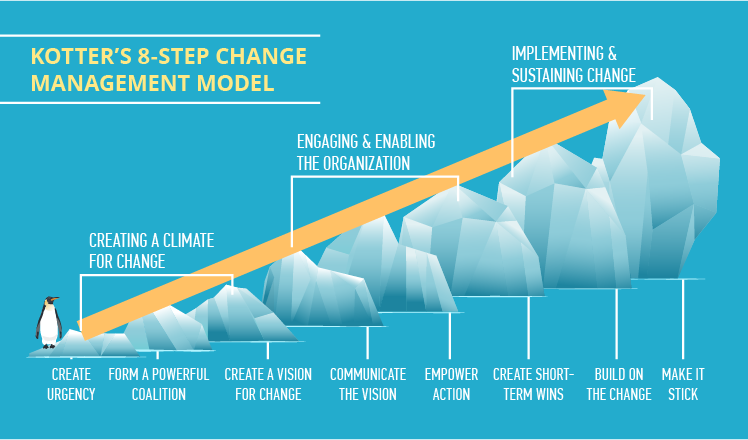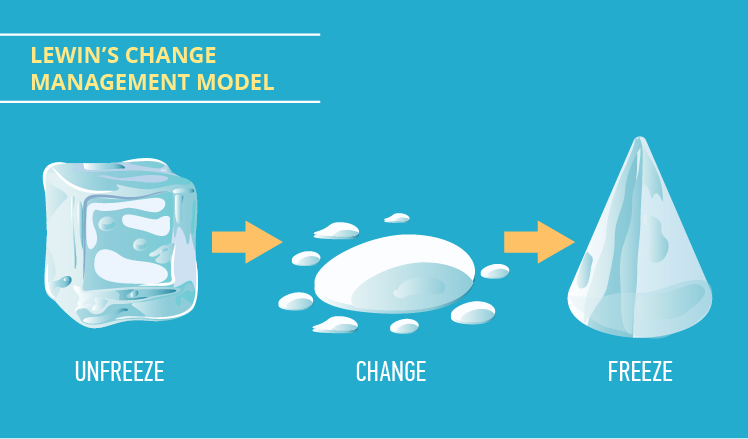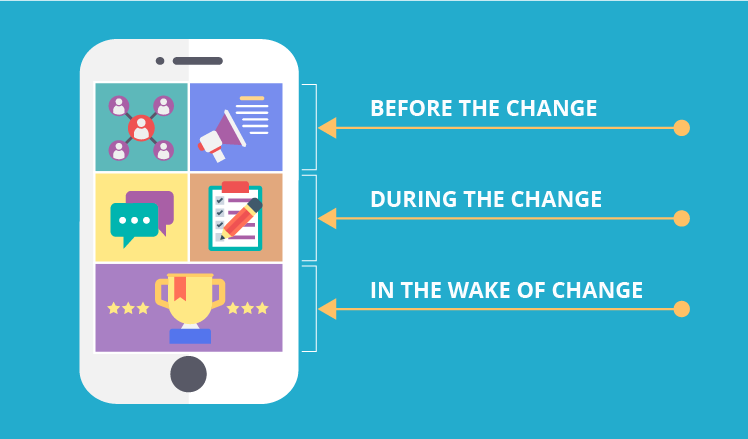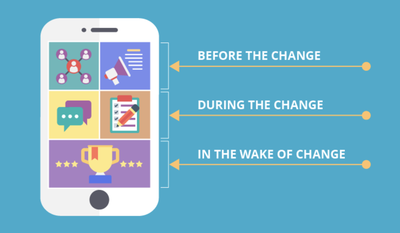Mobile App for Change Management in the Workplace
-
Editor's note: Requiring seamless interconnection of the organization's staff, change management is closely bound to mobility. If you want to smoothly and quickly lead your company through change, consider developing an effective change management mobile app with ScienceSoft's mobile experts.
Just by looking at the history of change management and more than 1,000 search results (as of this writing) for the ‘change manager’ vacancy on monster.com, it’s safe to make two assumptions.
First, change is important. More and more enterprises understand that Darwin’s theory of survival applies to businesses, too. Second, change is difficult. There are multiple models of going through an organizational change, but few of them can capture the challenge in all its aspects.
Combining these models with each other as well as with cutting-edge HRM technologies can significantly evolve and improve change management. That is exactly what this article is aimed at.
How it all started: penguins and ice cubes
To reintroduce his 8-step change management model from the classic 1996’ Leading Change, in 2005 Dr. John P. Kotter published Our Iceberg is Melting – a fable about penguins, who are forced to search for a new way of living, as danger approaches their home. Intentionally or not, Kotter’s ‘melting ice’ topic echoes back to the starting point of it all – Kurt Lewin's model created in the 1940s.

Lewin, a psychologist who seemed to admire equations as much as good metaphors, compared business change to a process of reshaping an ice cube into an ice cone. Consisting of 3 stages that logically reflect the ‘then – now – in the future’ triad of a change process, Lewin’s model inspired many others containing 3 steps too. Similarly, models with 4-10 steps, not excluding Dr. Kotter’s 8 steps, elaborate on Lewin’s initial model.
What change management lacks: democracy and flexibility
Fundamental change involves not only business reforms, but also intricate psychological transitions and ‘withdrawals'. For example, to turn obligatory tax payment into a customer service in the 1990s, the Internal Revenue Service had to reshape their employees’ entire behavior pattern, which required immense work and a lot of time, since it’s in the human nature to resist change.
Despite leaving space for resistance in theory, no model actually shows how to implement change in a manner different from the ‘top to down’ or unrealistic ‘command and control’ method. Moreover, some experts’ tips can be counterproductive if taken to the extreme (like, repeating the same vision statement over and over again). Such obtrusiveness can easily make employees completely turn their back on the idea.
Both Lewin’s and Kotter’s models tell about how communication is important during change, but some companies are not even office-based and have employees working in shifts or in the field. These organizations can face trouble with tuning their communication, yet they still have the right to go through the process of change successfully.
How to evolve change management with mobile
Letting people actively participate in the process of change and be its driving force is what both models, Lewin’s and Kotter’s, suggest. Still, most HR managers would agree that achieving employees’ engagement is one of the most difficult objectives a company may target at the time of change.
In other words, change would be faster, smoother and more efficient if everyone in the company were immersed in the process, played their roles in it and were interconnected. And that is exactly what mobility, with its extremely flexible nature, can offer for all the 3 steps of Lewin’s model.

1) Before the change
According to Lewin, ‘unfreezing’ a square ice cube means destroying the status quo. Kotter would later elaborate on this first step and highlight the need to announce oncoming changes and their prerequisites upfront, decide on the ‘vision’ the company should strive for and appoint the ones responsible for bringing the change to life.
How mobile helps:
-
Ranking the coalition
Elaborating on Lewin’s model, Kotter makes it clear that there should be a ‘counseling body’ to promote change in the company. To make this ‘coalition’ (as Kotter addresses it) diverse, experts advise to choose representatives of 4 major groups of employees that combine both high and low power with both high and low interest. However, are managers supposed to measure employees’ interest subjectively? Is ‘power’ defined only by a position? And, more than that, are power and interest the only important criteria?
To help HR managers at the preliminary stages of change, a mobile app can feature customized tests that will question not only employees’ attitude to change, but also their personal traits such as rationality, charisma, conservatism, etc. After results are sent to the backend, they will be automatically analyzed and group rankings will be created. With this, HR managers can make a much more reasonable choice of ‘coalition’ members based on the information they receive.
-
Relevant updates
Daily notifications sent out to employees’ mobile apps can be helpful for keeping them on the same page, whatever their work type or schedule is. Receiving a regular update on the change prerequisites (not in the form of pompous slogans, but as objective pieces of information about the market, company statistics or ratings), employees will be able to shape their own opinion and believe that change is indispensable and inevitable in its own right.
2) During the change
In his second step, Lewin describes a complicated and nearly unrealistic work of shaping the water from a melted square ice cube into a cone. Everything in business change is equally delicate, and any detail that slips through fingers can turn into a grave mistake. Constant support, prompt regulations, clear communication and ongoing engagement is what this step requires, and mobile software can bring it in.
How mobile helps:
-
Discussions and opinion polls
Communication is key to dealing with dissatisfaction and conflicts, and is essential to the change process. Yet, as already mentioned above, not all companies can have regular face-to-face communication due to their workflows.
Installed on portable devices, mobile apps can keep everyone in touch and get communication going. Special chatrooms with discussions of controversial issues can help employees to stay on the same page even if they are part-timers or work in the field. Moreover, opening up an opinion poll to hear from employees directly will make them feel valued.
-
Task management and feedback
What makes employees feel even more important to the company is being entrusted to fulfill change-related tasks, such as a special training, or culture studies in case of international mergers. Unfortunately, those often do not fit into a standard planning system or a schedule. What’s more, if simply listed along with common work procedures, these tasks can lose their specific nature and relation to change.
For staff to approach change-related tasks with all the attitude and perception they’ve formed so far, a mobile app can turn into an agile task-managing and feedback tool. With all the tasks listed separately on a mobile device, employees can receive instant notifications once a task was added, update the progress and request their line managers’ prompt assistance directly in the app. For management such an application is a convenient way to monitor performance and intervene when necessary.
3) In the wake of change
It’s virtually impossible to mark the moment when change is complete, so by Lewin’s ‘refreeze’ one shouldn’t understand consolidating the success.
Most companies ignore ‘short-term wins’ (Kotter’s term) for various reasons. Some think employees don’t take them seriously; some can’t come up with the gratification form, since financial bonuses are hard on any company that undergoes drastic changes. This final step is about what should be done as soon as at least some significant progress in change is noticed to engage people in keeping the progress going.
How mobile helps:
-
Achievements
Proven to be effective gamified elements, achievements and awards will keep workforce interested in the app and change process itself. A company can announce that awards will be monetized once the company gets over hard times, but even virtual badges or awards are way better than nothing at all. Moreover, excelling at change-related tasks in order to receive an achievement can become addictive, since such a scheme triggers a psychological aptitude for collecting that sleeps in all of us.

Keynotes
Like any theory, change management models offer logical but sometimes unrealistic solutions. Besides, employee engagement, being the core of a successful change, can hardly be fostered with pushing ideas and principles. Mobile software can become an effective tool capable of keeping employees informed, connected, engaged and motivated
-
